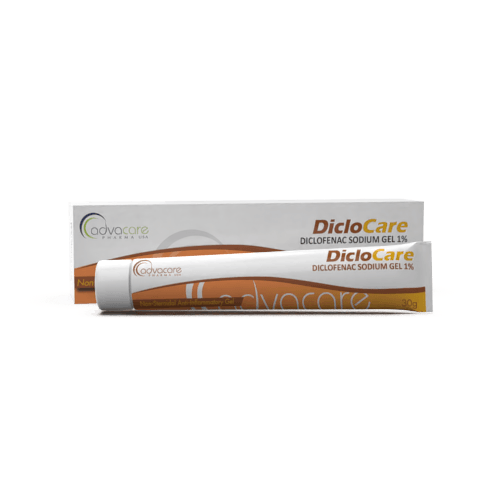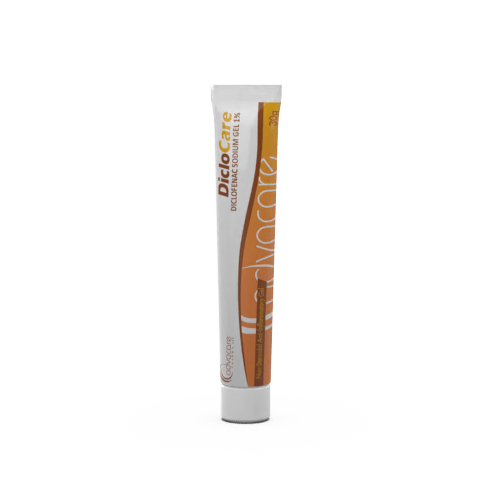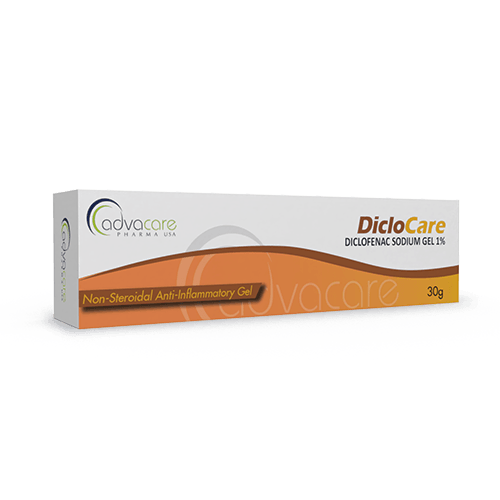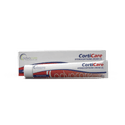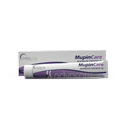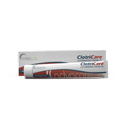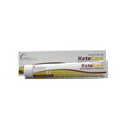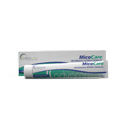- Home›
- Pharmaceuticals›
- Topicals›
- Medical Gels›
- Diclofenac Sodium Gel
Diclofenac Sodium Gel
Form
Dosage
Packaging
What is Diclofenac Sodium?
Active Ingredients: Diclofenac Sodium
Diclofenac Sodium Gel is a topical drug used to treat joint pain caused by osteoarthritis. It helps to reduce swelling, inflammation, stiffness, and other symptoms caused by arthritis. This medication is suitable for localized pain relief in the hands, wrists, elbows, feet, ankles, or knees.
Diclofenac sodium is classified as a non-steroidal anti-inflammatory drug (NSAID). Though the exact mechanism of action is not known, it is known to inhibit cyclooxygenase (COX-1 and COX-2), which produces its analgesic, anti-inflammatory, and antipyretic properties. The inhibition of COX-1 and COX-2 prevents the synthesis of prostaglandins, which are involved in inflammation and pain signaling.
AdvaCare is a GMP-certified producer and supplier of Diclofenac Sodium Gel. This medication is produced in our factories in China, India, and the USA. Our manufacturing facilities are regularly inspected and audited to ensure our products meet quality and safety standards.
Why are we a top Diclofenac Gel manufacturer?
AdvaCare Pharma is a US pharmaceutical company that manufactures Diclofenac Gel, and our entire range of 50+ topical treatments in cream, ointment and gel dosage forms, under stringent GMP regulations. Our distinctive approach to business fosters a highly collaborative relationship with our pharmaceutical distributors. For the past 20 years we have established a reputation as a trusted Diclofenac manufacturer, one of the 500+ pharmaceutical products in our comprehensive range, across more than 65 global markets.
Uses
What is Diclofenac Sodium used for?
It is used to temporarily relieve pain and reduce inflammation in the joints caused by osteoarthritis.
How is Diclofenac Sodium Gel used?
This medication is manufactured as a sterile gel intended for topical application directly to the skin. Always wash hands with soap and water before and after applying this medication. Use the hands to gently rub the gel into the skin. If the hands are being treated, wait at least 1 hour before washing hands. Do not shower or bathe for at least 1 hour after application.
Do not apply gel to broken skin.
When using Diclofenac Sodium Gel, avoid:
- Exposing the treated joints to natural or artificial sunlight.
- Contact with eyes and mucous membranes.
- Use of other topical products, including sunscreen, cosmetics, lotions, sprays, or other topical medications, on the treated joints.
- Wearing clothing or gloves for at least 10 minutes after application.
What dose should be taken and for how long?
For pain relief in the upper extremity joints, the recommended dose is 2g, applied up to 4 times a day. The maximum dosage is 8g per joint.
For pain relief in the lower extremity joints, the recommended dose is 4g, applied up to 4 times a day. The maximum dosage is 16g per joint.
Do not exceed the maximum daily dose of 32g, over all afflicted joints.
Diclofenac Sodium Gel has not been evaluated for use on joints of the spine, hip, or shoulder.
Refer to a doctor or healthcare professional for the exact dosage and duration of treatment.
Who can use Diclofenac?
Diclofenac Sodium Gel can be used by adults, but caution is advised for specific groups of patients.
Pregnant Diclofenac use is not recommended after 30 weeks gestation. Human studies on Diclofenac Sodium Gel use during pregnancy are limited. Human and animal studies have shown oral diclofenac does cross the placenta. NSAIDs, including diclofenac, increase the risk of premature closure of the fetal ductus arteriosus. If topical diclofenac treatment is deemed medically necessary during the third trimester, doses should be the lowest necessary to produce benefit and treatment should be as short as possible.
Nursing Diclofenac may be excreted in human milk in small amounts. The effects on nursing infants are currently unknown. Due to limited data, nursing while using Diclofenac Sodium Gel should be done with caution.
Pediatric The safety and efficacy of diclofenac sodium have not been established in pediatric patients.
Geriatric Current clinical data have not demonstrated differences in responses to Diclofenac Sodium Gel between older adults (≥ 65 years) and younger adults. Due to the increased risk of adverse events in older patients, dosage reductions in geriatric patients may be necessary because of age-related decreases in organ function and concomitant disease and drug therapy.
Other warnings
When using diclofenac sodium topically, natural or artificial sunlight exposure on the treated joint(s) should be avoided. Animal studies have found evidence that topical diclofenac may result in an earlier onset of skin tumors from UV light. The potential response to UV light in people using topical diclofenac is unknown.
Potentially fatal anaphylactic reactions that require immediate medical attention have been reported with NSAID use. Diclofenac hypersensitivity can cause adverse skin events, such as exfoliative dermatitis, Stevens-Johnson Syndrome (SJS), and toxic epidermal necrolysis (TEN), some of which can be fatal and can occur with or without warning. Topical diclofenac should be discontinued at the first sign of skin rash or other hypersensitivity reactions.
Diclofenac sodium contact with eyes and mucous membranes has not been studied and should be avoided. If eye contact does occur, the eye(s) should be washed with water or saline immediately. If irritation persists longer than 1 hour, contact a healthcare provider.
Concomitant use of topical and oral NSAIDs should be avoided, as it may increase the incidence of hemorrhage and result in more frequent abnormal creatinine, urea, and hemoglobin levels.
In patients with hepatic insufficiency, whether dosage adjustments are needed is unknown and reductions may not be necessary. Cases of rare, severe hepatic reactions, including liver necrosis, jaundice, fulminant hepatitis with and without jaundice, and liver failure, some of which resulted in fatalities or liver transplantation, have been reported with diclofenac use. These cases have primarily been reported with oral diclofenac; however, the risk should still be considered with topical diclofenac use. Diclofenac treatment should be discontinued immediately if signs of liver disease develop or if symptoms of systemic liver dysfunction occur.
In patients with renal insufficiency, whether dosage adjustments are needed is unknown and reductions may not be necessary. Long-term NSAID use can result in renal papillary necrosis and other renal injury. This risk of renal toxicity may be lower with topical diclofenac use, as it is only indicated for short-term use and is present in lower levels systemically.
Clinical studies of various NSAIDs have shown an increased risk of serious cardiovascular (CV) events, including myocardial infarction and stroke, which can be fatal. It is unclear if the risk of adverse CV events is similar for all NSAIDs. The increased risk of adverse CV events from NSAID use is similar in those with and without CV disease or dysfunction, however, those with CV disease or dysfunction had higher incidences of adverse CV effects. These effects can begin as early as the first weeks of treatment and have mostly been observed at higher doses. There is no evidence that aspirin can mitigate these risks, and aspirin use should be avoided, as it increases the risk of adverse gastrointestinal events. Diclofenac Sodium Gel use after coronary artery bypass graft is contraindicated due to the increased incidence of myocardial infarctions and strokes with NSAID use following surgery. Diclofenac use in patients with a recent myocardial infarction should be avoided.
NSAIDs, including diclofenac, can cause serious and potentially fatal gastrointestinal (GI) adverse events, including inflammation, bleeding, ulceration, and perforation of the esophagus, stomach, or intestines. Those with a longer duration of NSAID treatment, who are concomitantly using oral corticosteroids, aspirin, anticoagulants, selective serotonin reuptake inhibitors (SSRIs), or serotonin and norepinephrine reuptake inhibitors (SNRIs), and who have a history of liver disease, peptic ulcers, GI bleeding, or bleeding disorders are at an increased risk. These serious adverse events can occur at any time, and only approximately 20% of patients are symptomatic. Most cases involve long-term treatment, but short-term treatment with topical diclofenac is not without risk. Concomitant use of topical diclofenac with other oral or topical NSAIDs is not recommended due to the increased risk of adverse GI events.
The analgesic and anti-inflammatory effects of topical diclofenac may mask the clinical signs of present skin infection.
Side Effects
As with all pharmaceuticals, some unwanted effects can occur from the use of Diclofenac Sodium Gel.
Common side effects typically involve the application site and include, but are not limited to:
- itchy skin
- skin inflammation, redness, or dryness
- burning or tingling at the joint
Serious side effects that may require medical attention may include:
- signs of an allergic reaction
- swelling in the feet or ankles
- signs of internal bleeding (bloody or black and tarry stools, vomiting blood)
- easily bruising
For a comprehensive understanding of all potential side effects, consult a medical professional.
If any symptoms persist or worsen, or you notice any other symptoms, please call your doctor.
Precautions
Do NOT use Diclofenac Sodium Gel if:
- You are allergic to diclofenac sodium or any of the other ingredients.
- You are hypersensitive to any phenylacetic acid derivatives or other NSAIDs.
- You have a history of asthma or allergic reactions to NSAIDs or aspirin.
- You have a history of peptic ulcer or bleeding in the digestive tract.
- You have heart, kidney, or liver problems.
- You have recently had coronary artery bypass graft surgery.
Do not use this gel on broken or inflamed skin. Do not use after 30 weeks of pregnancy.
This medication may not be suitable for people with certain conditions, so it is important to consult with a doctor if you have any health conditions.
References
Randomized Controlled Trial of Diclofenac Sodium Gel in Knee Osteoarthritis
Topical nonsteroidal anti-inflammatory drugs offer local efficacy and low systemic drug levels. The main objective of this study was to assess the efficacy and safety of topical diclofenac sodium 1% gel (DSG) in mild to moderate knee osteoarthritis.
This randomized, double-blind, vehicle-controlled trial included 492 adults aged ≥35 years with symptomatic knee osteoarthritis of ≥6 months' duration. The patients were randomized to DSG 4 g (254 patients) or vehicle (238 patients) 4 times daily for 12 weeks. The Western Ontario and McMaster Universities Osteoarthritis Index (WOMAC) pain subscale, WOMAC physical function subscale, and global rating of disease were the primary measured outcomes. Secondary outcomes included these outcomes assessed after 1, 4, and 8 weeks, and pain on movement assessed using a 100-mm visual analog scale, also the adverse effects were recorded.
The results from the study showed that by week 12, the DSG group had big reductions compared to the vehicle group in the average WOMAC pain score (P = 0.01), average WOMAC physical function score (P = 0.001), and average global rating of disease (P < 0.001). Starting from week 1, efficacy outcomes favored DSG compared to the vehicle group. Application site reactions were reported in 5.1% of patients in the DSG group and 2.5% in the vehicle group. The occurrence of gastrointestinal disorders was 5.9% among those using DSG and 5.0% among those using the vehicle.
The conclusion of this research is that after 3 months of treatment, topical DSG can achieve statistical and clinical improvements in pain and measures of physical function in patients with knee osteoarthritis.

You might be interested in...
Why AdvaCare Pharma?
As an industry leader, we are aware of our responsibility to provide affordable and sustainable solutions to improve healthcare worldwide.
